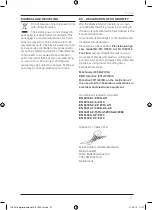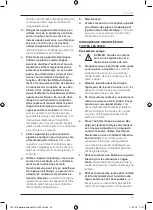
29
English
.
2. Switch on the tool and wait for two sec-
onds for the blade to run up to speed.
Next, plunge the blade into the material
slowly and gently, but firmly. Then push
the tool
forwards
along the line to be cut.
Never draw the tool backwards.
3. Once the finish line has been reached, lift
the tool from the work surface before
switching off. If a lot of dust has been
created, keep switched on for a few sec-
onds extra to allow the dust to clear from
within the tool.
Attaching the Parallel Guide
1. Pull out the power Plug.
2. Remove the Screw (8) on the safety cut-
ting shoe.
3. Insert the parallel guide and secure it with
the screw (8).
Cutting Difficult or Dusty Materials
Practice using the tool by cutting wood before
attempting to cut anything tougher. When
cutting tougher material, such as metals and
some plastics, more force is required to hold
the work piece and clamping may be required.
Do not cut materials that produce toxic
dust or fumes such as PTFE or asbestos.
Sheet Metal
• Always set the depth adjustment to at
least 1 mm greater than the material thick-
ness to avoid the blade riding up over the
surface. Scrap material is required under-
neath the work surface.
• Remove burrs and rust as these impede
the feed across the material.
• Do not cut steel.
• Every 2 minutes of metal cutting should be
followed by a rest of at least 3 minutes.
Ceramic Tiles, Slates or Similar
Material
• Only use a blade specifically designed for
the purpose.
•
Always
use with a suitable vacuum
cleaner or dust extractor connected as the
dust can be hazardous to the operator
and prevent the safety cutting shoe from
operating correctly.
• Applying masking or PVC tape to the base
plate of the tool, or alternatively to the
work piece can make cutting easier and
avoid scratching the tile.
Plasterboard
• This saw is only recommended for making
occasional cut outs in plasterboard, and
should only be used with a suitable vac-
uum cleaner or dust extractor connected.
The dust can prevent the safety cutting
shoe operating correctly.
• Although conventional tools such as key-
hole saws or knives generally give excel-
lent results, the Precision Saw is ideal if a
particularly neat and dust free cut is
required or if there is a danger of cutting
pipes or cables.
CLEANING AND MAINTENANCE
Warning!
Pull out the power plug
before any cleaning work.
Cleaning
• Keep safety devices, ventilation openings
and the motor housing as free as possible
from dirt and dust. Rub the electric power
tool with a clean cloth or blow over it with
low pressure compressed air.
• We recommend that you clean your elec-
tric power tool immediately after each use.
• Clean the electric power tool regularly with
a damp cloth and somewhat soft soap. Do
not use any cleaning or solvent materials;
these can attack the device’s plastic com-
ponents. Make sure that no water can get
inside the electric power tool.
• Unlock and remove the lid if the adapter is
dusty. Replace the lid after cleaning.
Maintenance
Carbon brushes
In the event of excessive sparking, allow a
qualified person to examine the carbon
brushes.
ATTENTION!
The carbon brushes
may only be exchanged by a qualified
person.
There are no inner parts of the tool which need
maintenance.
7062413-digital-display-MA-#-1604-19.indb 29
11-05-16 11:37
















































